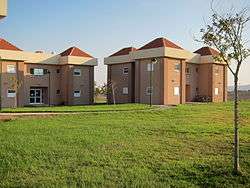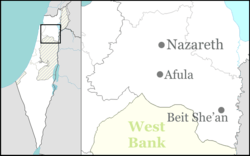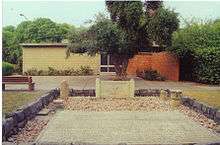Ein HaNetziv
| Ein HaNetziv | |
|---|---|
 | |
 Ein HaNetziv | |
| Coordinates: 32°28′12.71″N 35°30′8.64″E / 32.4701972°N 35.5024000°ECoordinates: 32°28′12.71″N 35°30′8.64″E / 32.4701972°N 35.5024000°E | |
| District | Northern |
| Council | Valley of Springs |
| Affiliation | Religious Kibbutz Movement |
| Founded | 1946 |
| Founded by | Bnei Akiva members |
| Population (2017) | 618[1] |
| Website | http://www.hanatziv.org.il/ |
Ein HaNetziv (Hebrew: עֵין הַנְּצִי"ב, lit. Spring of the Netziv) is a kibbutz in the Beit She'an Valley in northern Israel. Located about three kilometers south of the ancient city of Beit She'an, it is 130 meters below sea level and falls under the jurisdiction of Valley of Springs Regional Council. In 2017 it had a population of 618.[1]
Etymology
The name derives from the initials of Rabbi Naftali Zvi Yehuda Berlin, the "Netziv of Volozhin" (1816 – 1893), who was one of the greatest rabbis of Russia at the end of the 19th century.
History

The kibbutz was established on 17 January 1946 on a site known as "el-Wakwaka" by a group of young people of the Bnei Akiva Movement from Germany. In the late 1960s, while preparing the lands for cultivation, members of the kibbutz discovered the Mosaic of Rehob among the ruins of an ancient synagogue.
Economy
The economy of the village today is based on agriculture (a herd of about a thousand cattle, extensive orchards of date palms and olive trees, cereal crops) and a plastics factory, Palziv, which exports all over the world.[2]
Education
Within the kibbutz there are several educational establishments, including the Religious Kibbutz Movement's religious seminary for young women (Midreshet Kibbutz HaDati), and an intensive study course or "ulpan" for French speakers wishing to convert to Judaism, which offers Hebrew language and Orthodox Judaism classes.[2][3]
References
- 1 2 "List of localities, in Alphabetical order" (PDF). Israel Central Bureau of Statistics. Retrieved August 26, 2018.
- 1 2 Conversion ulpan programs Religious Kibbutz Movement
- ↑
| Wikimedia Commons has media related to Ein HaNetziv. |